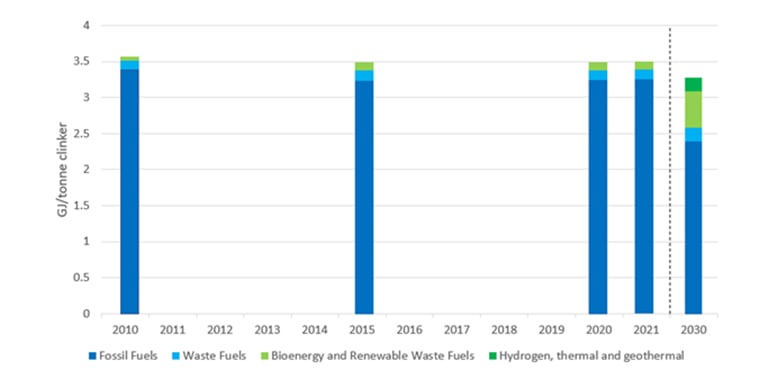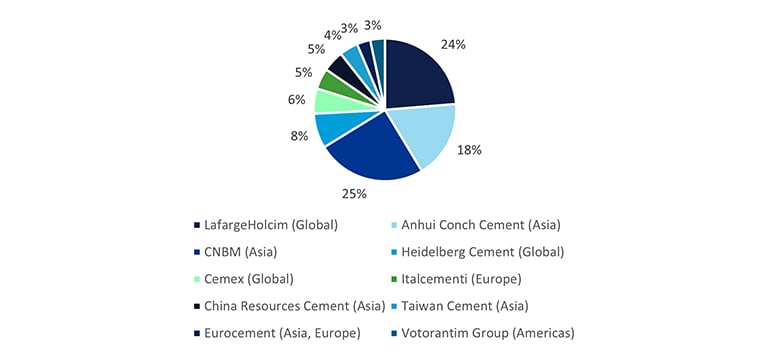Why is the cement industry labelled hard-to-abate?
Cement is the main component in concrete, which is the second most consumed resource in the world, after water.
Unfortunately, production of this popular material accounts for as much as 7% of global CO2 emissions, with each tonne of cement produced emitting 0.6 tonnes of CO2 on average.
Cement is mainly produced through the dry kiln process, which consists of four main stages:
- Raw materials (mainly limestone and clay) are quarried, crushed, ground, and then fed into kilns (large rotating cylindrical furnaces).
- The material is heated to 1450°C using a mixture of fuels. During this process CO2 is driven off calcium carbonate (CaCO3). Clinker is formed in the kiln.
- Clinker is cooled, ground, and mixed with gypsum and limestone.

Figure 1: Kiln process (Sourced: Carbon Brief, Chatham House).
In the current cement production process, CO2 is unavoidable as it is formed chemically and thermally, responsible for 60% and 40% of the production’s total CO2 emissions respectively.
How will the industry decarbonize?
Companies are seeking ways to reduce CO2 emissions both directly and indirectly, including:
- Reducing indirect emissions by using decarbonized electricity.
- Increasing thermal energy efficiency to reduce fuel usage.
- Switching to low-carbon fuels (process fuels and in transport).
- Using alternative raw materials (substitutes and supplements to natural resources).
- Reducing clinker to cement ratio.
- Carbon capture, utilization, and storage (CCUS).
Although easier to implement, some reduction methods will depend on the progress in other industries and will also vary between countries. For example, the use of decarbonized electricity in the cement industry will depend highly on the speed of renewable electricity uptake, as well as the speed and timing of network transformation to accommodate renewables generation.
As shown by the UK’s Concrete and Cement Industry Roadmap, each technology lever will account for different CO2 savings and will be implemented at different stages of the industry’s decarbonization strategy. For example, short-to-medium term strategies will include switching to alternative fuels and is expected to contribute considerably to CO2 reduction as it means a move away from fossil fuel usage.
Most sites are already substituting a proportion of their fuel mix for waste and biomass fuels. Carbon trading schemes, such as the EU ETS, are used to encourage reduction in greenhouse gas (GHG) emissions and oblige CO2 emitters to buy CO2 permits on the market to cover some of the pollution that they emit. Provided that the biomass meets the minimal sustainability criteria, emissions from biomass are ‘zero-rated’ under the EU ETS.
Burning biomass will still have a GHG footprint and this will depend upon the whole value chain (i.e., fertilizers, transport, drying, etc). Burning low carbon waste fuels will also negatively impact the environment, therefore, hydrogen has a role to play to truly improve the sustainability of the cement process.
Hydrogen and the cement industry
Green1 and blue2 (low carbon) hydrogen present a promising pathway of decarbonizing the cement industry as opposed to electrification, since hydrogen is a near ‘drop in’ substitute and electrically powered kiln technology is at a low Technology Readiness Level (TRL).
Although switching to hydrogen would result in immediate abatement in CO2 emissions, the cement process cannot readily make the switch to 100% hydrogen tomorrow. For significant substitution rates, most cement sites would require a major redesign of their burner (the piece of equipment where fuels are combusted) and in addition, the availability and infrastructure for green and blue hydrogen is currently limited.
Hydrogen injection – a blend of hydrogen and fossil fuels – is more feasible for the industry as it is more readily deployable and potentially doesn’t require burners to be redesigned. The availability of sufficient hydrogen for use by industrial consumers is set to grow gradually with some adoption later this decade, but it’s likely other sectors, particularly the industrial clusters, who are going to be the early adopters of low carbon hydrogen. The Global Cement and Concrete Association roadmap appears to share this view as they forecast hydrogen playing a small role for the industry from 2040 onwards.

Figure 2: Fuel substitution projection for Net Zero Emissions (source: IEA).
How is hydrogen being used by the industry?
The cement industry consists of lots of companies that own multiple cement sites. The sectors five largest companies are responsible for over 80% of cement production capacity. Therefore, for the industry to change significantly, we can look to their values, commitments, and current projects to assess which technology the industry will implement to achieve its sustainability targets.

Figure 3: 2020 cement production capacity by company (Data source: BizVibe)
Within its 2022 climate report, Lafarge Holcim have stated that it is assessing hydrogen for two main applications: its use as a replacement for fossil fuels and to support CCUS (using captured CO2). The company is currently involved in two hydrogen projects: Hyscale100 and Go4Zero in which it is upgrading its kilns to enable oxyfuel combustion, enabling more efficient CO2 capture which will produce synthetic fuel by reacting with hydrogen.
In its 2021 sustainability report, Heidelberg Materials shared its ambition to decarbonize its cement sites by raising the proportion of biomass fuels, exploring the use of hydrogen and increasing electrification of their processes. Its UK-based subsidiary, Hanson UK, has conducted trials using hydrogen at two of its three sites. The site in Ribblesdale is operated using a net zero fuel mix as part of a world-first demonstration using hydrogen technology and the Padeswood cement site is to be part of the UK’s Track 1 Industry Cluster HyNet, where the sites CO2 emissions will be captured and stored.
Within its 2021 integrated report, CEMEX has stated that it has created yearly CO2 roadmaps, developed to meet its 2030 sustainability targets. These roadmaps include increasing use of alternative fuels and electricity from clean sources and utilizing energy efficiency enhancers such as hydrogen. In partnership with HiiRoc, CEMEX has developed a new hydrogen injection technology to scale up the adoption of hydrogen in all its cement operations.
Is CCUS the answer?
Even with full conversion to fuels with no anthropogenic emissions, the cement process will still produce CO2. Carbon capture will have to be deployed as a long-term strategy to achieve net zero, it is currently responsible for capturing 0.1 Mtonnes of cement emissions and is expected to increase rapidly over the decade. Heidelberg Materials Norcem cement site is to be the world’s first CO2 capture facility, capturing 400,000 tonnes annually. Operational by 2024, the CO2 will be stored in the North Sea as part of Norway’s Longship project.
Coupling the CO2 captured with green hydrogen can produce a range of e-fuels. This could see synergies develop between hydrogen hubs and cement industries such as the Carbon2Product Austria scheme that captures CO2 from Lafarge Holcim’s Mannersdorf cement plant and reacts with green hydrogen to form a sustainable hydrocarbon fuel.
The route to decarbonization
By 2050, some sectors such as power have the capability to reach net zero but the hard-to-abate sectors such as the aviation, maritime and cement are not expected to be net zero by this date.
Hydrogen is a promising resource for the industry and would be more readily available later this decade. In the short-to-medium term, the cement industry is expected to increase thermal efficiencies, reduce the clinker to cement ratio as well as increase the biomass fuel substitution rates, moving away from fossil fuels. Long-term strategies will include the use of green/blue hydrogen or its derivatives to e-fuels and would involve techno-economic considerations and assessing trade-offs. To be part of the low-carbon future, CCS is expected to be heavily relied upon as a key component of the long-term net zero strategy for the cement industry.
The route for decarbonization is not straightforward but with the right expertise and vision the industry can strategize its decarbonization pathway.
Adding value
Learn how our Energy Strategy advisors provide assurance to stakeholders of some of the world’s most capital-intensive projects. Contact Tegan Norster to learn more.
References
1 Hydrogen produced using electrolysis powered by renewable electricity (from solar or wind etc.).
2 Hydrogen produced from fossil fuels via SMR, gasification etc. with carbon capture.
3/21/2023 8:00:00 AM
